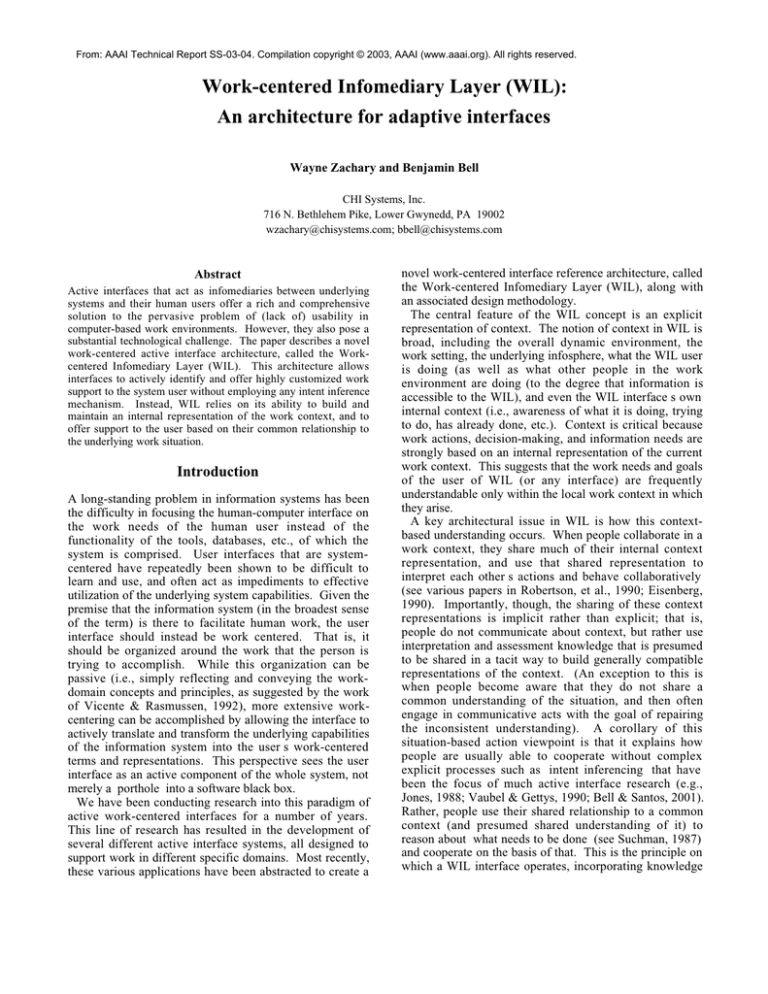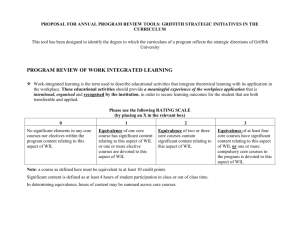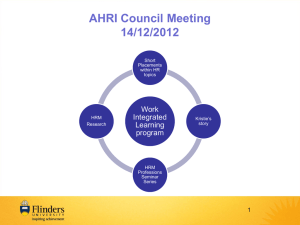
From: AAAI Technical Report SS-03-04. Compilation copyright © 2003, AAAI (www.aaai.org). All rights reserved.
Work-centered Infomediary Layer (WIL):
An architecture for adaptive interfaces
Wayne Zachary and Benjamin Bell
CHI Systems, Inc.
716 N. Bethlehem Pike, Lower Gwynedd, PA 19002
wzachary@chisystems.com; bbell@chisystems.com
Abstract
Active interfaces that act as infomediaries between underlying
systems and their human users offer a rich and comprehensive
solution to the pervasive problem of (lack of) usability in
computer-based work environments. However, they also pose a
substantial technological challenge. The paper describes a novel
work-centered active interface architecture, called the Workcentered Infomediary Layer (WIL). This architecture allows
interfaces to actively identify and offer highly customized work
support to the system user without employing any intent inference
mechanism. Instead, WIL relies on its ability to build and
maintain an internal representation of the work context, and to
offer support to the user based on their common relationship to
the underlying work situation.
Introduction
A long-standing problem in information systems has been
the difficulty in focusing the human-computer interface on
the work needs of the human user instead of the
functionality of the tools, databases, etc., of which the
system is comprised. User interfaces that are systemcentered have repeatedly been shown to be difficult to
learn and use, and often act as impediments to effective
utilization of the underlying system capabilities. Given the
premise that the information system (in the broadest sense
of the term) is there to facilitate human work, the user
interface should instead be work centered. That is, it
should be organized around the work that the person is
trying to accomplish. While this organization can be
passive (i.e., simply reflecting and conveying the workdomain concepts and principles, as suggested by the work
of Vicente & Rasmussen, 1992), more extensive workcentering can be accomplished by allowing the interface to
actively translate and transform the underlying capabilities
of the information system into the user s work-centered
terms and representations. This perspective sees the user
interface as an active component of the whole system, not
merely a porthole into a software black box.
We have been conducting research into this paradigm of
active work-centered interfaces for a number of years.
This line of research has resulted in the development of
several different active interface systems, all designed to
support work in different specific domains. Most recently,
these various applications have been abstracted to create a
novel work-centered interface reference architecture, called
the Work-centered Infomediary Layer (WIL), along with
an associated design methodology.
The central feature of the WIL concept is an explicit
representation of context. The notion of context in WIL is
broad, including the overall dynamic environment, the
work setting, the underlying infosphere, what the WIL user
is doing (as well as what other people in the work
environment are doing (to the degree that information is
accessible to the WIL), and even the WIL interface s own
internal context (i.e., awareness of what it is doing, trying
to do, has already done, etc.). Context is critical because
work actions, decision-making, and information needs are
strongly based on an internal representation of the current
work context. This suggests that the work needs and goals
of the user of WIL (or any interface) are frequently
understandable only within the local work context in which
they arise.
A key architectural issue in WIL is how this contextbased understanding occurs. When people collaborate in a
work context, they share much of their internal context
representation, and use that shared representation to
interpret each other s actions and behave collaboratively
(see various papers in Robertson, et al., 1990; Eisenberg,
1990). Importantly, though, the sharing of these context
representations is implicit rather than explicit; that is,
people do not communicate about context, but rather use
interpretation and assessment knowledge that is presumed
to be shared in a tacit way to build generally compatible
representations of the context. (An exception to this is
when people become aware that they do not share a
common understanding of the situation, and then often
engage in communicative acts with the goal of repairing
the inconsistent understanding). A corollary of this
situation-based action viewpoint is that it explains how
people are usually able to cooperate without complex
explicit processes such as intent inferencing that have
been the focus of much active interface research (e.g.,
Jones, 1988; Vaubel & Gettys, 1990; Bell & Santos, 2001).
Rather, people use their shared relationship to a common
context (and presumed shared understanding of it) to
reason about what needs to be done (see Suchman, 1987)
and cooperate on the basis of that. This is the principle on
which a WIL interface operates, incorporating knowledge
about the work domain and using it actively to build and
maintain an understanding of the work domain and the
current context within the work environment (which
includes the human user). The context is then used to
construct various forms of work-centered support, which
are customized to the current situation.
Procedural/Dynamic
Domain Ontology
(How to think about
domain dynamics)
User Transactions/events
Context
significance
Declarative
Domain Ontology
(How to think about
work domain)
Infosphere
transactions/events
Dynamic
Context
Model
Context
significance
Interaction Managen’t/
Broker
User Action/Needs
Prediction
Support Generation
and tailoring
Work/Needs
Decision/Performance
Prediction Knowledge
support knowledge
(How to interpret/predict
what user will/does needs)
Domain
transactions/events
Infosphere search/
retrieval knowledge
Infosphere
Information Source
Infosphere Transaction
Agent/process
Infosphere
Information Source
Communication/network
management knowledge
Infosphere
Information Source
Back
Plane-
Context
significance
Infosphere Widget
Midplane
WIL Interface Widget
Frontplane
Worker/user
Underlying system
software and functionality
Figure 1. WIL Conceptual Architecture
Organization of computation in WIL
The conceptual WIL architecture is shown in Figure 1. At
the highest level, the architecture is divided into frontplane, mid-plane, and back-plane components. A WIL
interface interacts with the human user through a series of
direct interaction objects (i.e., widgets), whose look and
feel are tied both to the work domain and the interface
functionality they present. These direct interaction objects
are managed as a front-plane layer, which can either be
integrated with the (legacy) information system displays
and controls (in which they pass thru the remainder of the
WIL) or serve as the complete user interface to the
underlying information system.
A WIL application also needs to interact with various
algorithmic components, databases, data streams, etc. that
make up the external infosphere. The functionality that
allows WIL to interact with this infosphere make up the
back-plane. This allows the WIL interface to avoid being
the end-point to a stovepipe , connected to only a single
data source or underlying system. More importantly, the
breadth of the backplane gives the interface access to the
information it needs to develop and maintain its context
model (and allows it to do so on either an active or a
passive basis).
In between the front-plane and back-plane of Figure 1
lies the mid-plane, which is the main locus of the active
processing within WIL as an active interface architecture.
A WIL interface simultaneously and continuously performs
three general functions within the mid-plane:
• determining what the current work context is (the
understanding function)
• identifying what work needs to be done given the
current context (the work/need assessment function);
and
• support those users work needs in light of the current
work context (the tailored support function).
The mid-plane is consists of a set of three major
infrastrucural processes that implement these functions.
These processes:
• automate the understanding function by representing
work context explicitly and maintaining a dynamic
understanding of the current work context;
• automate the work/need assessment function by using
context-driven interpretation techniques; and
• automate the tailored support function by dynamically
adapting a set of generic work-support processes, using
the content of the dynamic context representation.
Clearly, the results of the tailored support function are
the only aspect of mid-plane processing that the human
user working with the WIL interface sees. The
understanding functions and actions/need assessment
functions are the enabling capabilities that allow the WIL
interface to be helpful to the user without an explicit intent
inferencing process.
Mid-plane Processing Structure
As stated above and shown in Figure 1, the mid-plane of a
WIL interface is organized into three interacting processes,
corresponding to the three functions listed above. Each is
discussed in additional detail below, although space
limitations preclude an in-depth analysis. The discussion
for each process is framed first in general terms, and then
in terms of the types of domain-specific knowledge that
must be built into the WIL interface to apply that process
in a specific application domain.
The understanding function: building and maintaining
work context. Cognitive research has consistently shown
that human decision-making and information processing
are organized around an internal representation of context
(see, for example, theoretical discussions by Barwise and
Perry, 1983, Pylyshyn, 1984, Klein ,1989, Kolodner, 1991;
Endsley, 2000). The WIL architecture takes a similar
approach, representing context as an explicit internal body
of knowledge about the domain, about current and
evolving objects (abstract or concrete) and relationships
among them, and about the set of intelligent entities within
the work environment (including the WIL itself). The
context representation also may include the projected (in
time and space) significance, effects, and/or behavior of
objects or relationships that are part of the context.
WIL represents context as a complex body of declarative
knowledge organized into an ontology that is usually
highly specific to the work domain and work role being
supported by the WIL application. Importantly, the body
of information in the context model is selective rather than
exhaustive. This is also cognitively rooted, reflecting the
tendency of human experts to learn the types of
information that are relevant and seek (only) those,
ignoring the much larger body of irrelevant data as the
cognitive equivalent of noise. Thus, building an internal
context representation requires not just knowing how to
’think about the domain’ (i.e., possessing the structure of
the appropriate ontology and ability to instantiate it), but an
additional set of cognitive and perceptual processes that
can selectively acquire this relevant information and relate
it to the context ontology.
These processes themselves fall into two categories -those that deal with information in the environment outside
the system, and those that seek information inside the
system. The former (externally-oriented processes) are the
analog of human perceptual processes. They interpret
information received from events and processes outside the
system (i.e., from outside the WIL) and internalize it in
terms of the domain ontology that structures the internal
context model. The actual acquisition of external world
information for these perceptual processes occurs through
the analog of sensory processes in the back-plane or the
front plane, depending whether the information concerns
the human user of the WIL (on whom information is
acquired through the front-plane), or concerns the
environment, other people in the system, or the infosphere
(about which information is acquired through the backplane). These perceptual processes require the domainspecific perceptual knowledge needed to interpret the ’raw’
data acquired through the front- or back-plane and to
translate that data into internal knowledge that becomes
part of the context model. In the case of infosphere
retrieval, the sensory-like processes may also require
extensive procedural knowledge concerning how to locate
and interrogate the information source itself.
The internally-oriented processes also include two subtypes, which are the analogs of interpretive and
metacognitive processes in people. Interpretive processes
are reasoning processes that operate on information already
in the context model and infer more new, often more
abstract, information. For example, externally oriented
processes may acquire information about aircraft tracks
from a geographical plot (such as an air traffic control
display), and internalize these tracks symbolically as part
of the context model. Internally oriented reasoning
processes might operate, for example, on the individual
track knowledge currently in the context model to seek out
and identify tracks that are traveling as a group or
formation, and make the formation itself part of the context
model as well. These interpretive processes are activated
by the presence of actionable information in the context
model, and require both the procedural knowledge needed
to carry out the interpretive context, and the control
knowledge needed to define the activation conditions. The
metacognitive processes are reasoning processes that
operate on the state/actions of the cognitive process itself.
These are the processes by which information on the
internal operation of the WIL mid-plane is transformed into
a symbolic representation and internalized as part of the
context model itself.
The work/need assessment function: identifying
contextually-appropriate work needs. The context-based
approach allowed the interface to identify appropriate
things that needed to be done, and to offer full, partial, or
supportive automation in performing them. Rather than
determining what the user is doing, or trying to do, or
wants to do, the WIL architecture instead takes an
approach much more commonly used by humans beings
who are trying to collaborate. It analyzes the context
model and tries to determine what kinds of work activities
need to be done, what kinds of information is needed (to do
them), and/or what changes in viewpoint, level of
abstraction, or frame of reference might be useful at the
current moment. As the various processes carrying out the
understanding function (see above) change the context
model, the set of current work needs may also
correspondingly change. Some activities that were relevant
a moment earlier may now be in appropriate, just as new
information needs, etc. may arise.
In computational terms, each of the three broad
categories of work needs -- work activities, information
needs, viewpoint/abstraction frames -- will be associated
with a set of spontaneous computation units. Each of these
units can recognize, for a specific content element (e.g.,
specific work activity or specific information need), the
context cues which define several different attributes or
state of that category of work need. These attributes or
states include such things as:
• activation -- conditions that recognize that it is now
relevant,
• sustainment -- conditions that keep it activated,
• accomplishment -- conditions that recognize that it has
been completed or satisfied, and
• deactivation -- conditions that recognize that it is no
longer relevant.
As these attributes are computed, they themselves
become part of the context model, via internally-directed
metacognitive processes.
The tailored support function: generating contextbased end-user support. As the WIL application identifies
specific elements or aspects of work that need to be done,
these too become part of the work context, as shown on
Figure 1 above. From these work needs, then, the interface
can identify specific things that it could do to help the WIL
user meet these work needs. Although these work-support
functions could be developed in a purely domain-specific
manner for each new WIL application, a set of general (in
the sense of commonly-occurring) work support strategies
have been defined from analysis of a set of past WIL
applications (see Zachary et al., 2001). Table 1 defines the
set of nine general work support functions from that
analysis. By incorporating generalized processes which
can perform each of these functions into a WIL application,
the process of providing each type of support reduces to
one of tailoring each generic process, according to the
needs of the specific application and current context. (Of
course, other work-support functions could also be
incorporated as needed on a domain-specific basis.)
Table 1. WIL Work-Centered Support Functions
Function
Description
Activity Management
helping the person determine what work tasks or elements need to be done at
the current point in time, given the current work context
Work Process Structuring
helping the person determine how a given work task or element ought to be
approached or broken down, given the current context of the work
environment
Customized Performance Assistance performing, at the request or approval of the person, a given work task or
sub-element
Explanation/Elaboration
providing explanations of system, sensor, infosphere events or processes in
terms of their impact or effect on the user s own work and work needs
Work-Environment Representation
constructing and displaying multiple abstracted representations of the
structure and processes in the work domain or environment
Infosphere data retrieval
going out into the information environment, outside the interface itself (i.e.,
into data streams, databases, etc.), to collect and make available pieces of
information
What if
allowing the user to create a hypothetical work view in which possible future
actions are defined and explored
Situation Awareness
providing information at multiple levels of abstraction on the external system
or process (e.g., the battlespace) with which the user s work is involved
Work-flow Prioritization
helping the person determine which, among many work elements or tasks
that need to be done at a given time, have priority in the current work context
and why
For example, activity management could be offered
whenever the process of identifying work needs determines
that multiple work activities needed to be performed
simultaneously, thus signaling a case where the human user
might benefit form activity management support.
The
tailoring process, in this case, simply involves associating
the linking content from the context (i.e., work activities
that need to be done) with the abstracted sub-process that
manages activity management and its interactions with the
user via the front-plane. Analogous approaches work for
the other general work support functions.
Conclusion
The main idea advanced here is that WIL interfaces are
able to provide functions that are typically associated with
active interface or associative systems, but without any
intent inferencing whatsoever. Instead, the approach relies
on the shared relationship to the overall situation as the
basis for determining what type of support is to be offered
to the user, and when.
The WIL concept and architecture was developed
through an analysis of and abstraction from a series of prior
active interface applications, all of which used the contextbased approach described here. Those prior applications
were all coded essentially by hand, and required substantial
time and effort to implement (even that development
process employed a high-level cognitive modeling toolkit
that reduced the effort). A main motivation of the
definition of the WIL architecture was to create an
opportunity to further automate, streamline and structure
the development process. The authors are currently
working on implementing the WIL as a generalized
software framework along with a set of tools to customize
it to specific application contexts. These tools both help to
capture domain-specific knowledge and to integrate this
domain-specific knowledge with the general WIL software
structures to yield a domain-specific WIL application.
This WIL-Application Toolkit (WAT) can be used to
develop, customize, and maintain specific WIL
applications.
References
Barwise, J., & Perry, J. 1983. Situations and Attitudes.
Cambridge, MA: MIT Press.
Bell, B. and Santos, E. (Eds.) 2001. Intent Inference for
Collaborative Tasks: Papers from the 2001 Fall
Symposium. Technical Report FS-01-05, American
Association for Artificial Intelligence.
Eisenberg, E. M. 1990. Jamming: Transcendence Through
Organizing. Communication Research, Vol. 17, No. 2,
Sage Publications.
Endsley, M.R. 2000. Theoretical Underpinnings of
Situation Awareness: A Critical Review. In Endsley,
M.R. and Garland, D.J. (Eds.), Situation Awareness
Analysis and Measurement. Mahwah, NJ: Lawrence
Erlbaum Associates.
Jones, P., Mitchell, C., & Rubin, K. 1988. Intent
Inferencing with a Model-Based Operator’s Associated
(Rep. No. 88-2). Atl, GA: G. Inst. Tech., School of
Industrial and Systems Engineering.
Klein, G. 1989. Recognition-primed decisions. In W.
Rouse (Ed.), Advances in man-machine systems research.
(pp. 47-92). Greenwich: JAI Press.
Kolodner, J. 1991. Improving Human Decision Making
Through Case-Based Decision Aiding. AI Magazine, 12(2)
Pylyshyn, Z.W. 1984. Computation and Cognition Toward
a Foundation for Cognitive Science. Cambridge: The MIT
Press.
Robertson, S., Zachary, W., and Black, J., Eds. 1990.
Cognition, Computation and Cooperation: An
Interdisciplinary Study of Multi-Agent Systems. Norwood:
Ablex Press.
Suchman, L. 1987. Plans and situated actions: The
problem of human-machine communication. Cambridge,
England: Cambridge University Press.
Vaubel, K. P., & Gettys, C. F. 1990. Inferring User
Expertise for Adaptive Interfaces, Human Computer
Interaction, Vol. 5, pp. 95-117, Lawrence Erlbaum.
Vicente, K. J. and J. Rasmussen 1992. Ecological interface
design: theoretical foundations. IEEE Transactions on
Systems Man Cybernetics 22(4): pp. 589-606.
Zachary, W. Schremmer, S., & Donmoyer, J. 2001. Design
Analysis for A Work-centered Infomediary Application
Toolkit. CHI Systems Technical Report 011214.01011,
Lower Gwynedd, PA: CHI Systems Inc.





